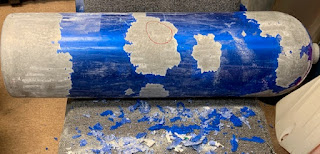Scuba Cylinder Quiz - The Answer Key!
 |
| Image: Pixabay |
By Fred Stratton
Instructor & Repair Technician
fred@bubblesornot.com
Special Edition - Cylinder Summary and Answer Key
All right, BoN Crew, how did you do on the cylinder markings quiz? I'm sure you passed with flying colors!
Cylinders 101 & 202 - Summary
Now that we've covered cylinder markings you can stay away from sketchy cylinders you may find at yard sales or online. Invest in quality equipment that - with TLC and regular maintenance - will give you decades of reliable service. You might even be more vigilant when renting cylinders during dive trips. If it looks, smells or feels wrong (no VIP sticker, out of date hydro, diesel odor present when you crack the valve, etc.), ask for different cylinders. If the staff look at you sideways, find a more reputable dive shop.
Avoid buying used cylinders made from 6351 alloy. If you have 6351s and just can't part with them, remember to include the price of eddy current tests ( a $15 to $25 test) in the overall cost of keeping these cylinders serviceable. Doing the math quickly reveals that retiring 6351s is financially prudent. This DAN Alert Diver article on 6351-T6 alloy scuba cylinders authored by Mark Gresham of PSI-PCI will help you make an informed decision.
This Tech Bulletin provides specific dates when Luxfer switched from 6351 to 6061 alloy for each cylinder size (e.g. S72 and S100 in August 1987, M9 in January 1988).
Cylinder Markings Quiz Answer Key
Time to test your knowledge.
Cylinder One
 |
A: Luxfer Cylinders (middle right)
A: In May 1980 (bottom stamp 5 80)
Q: Is it steel or aluminum?
A: Aluminum: Note the E6498 original DOT stamp at top center. A hydrostatic retesting facility correctly stamped 3AL above E6498 after a successful subsequent hydro.
Q: Is it made of 6351-T6 alloy or 6061-T6 alloy?
A: Luxfer made aluminum cylinders using 6351 alloy from November 1971 through May 1988, so this is a 6351 cylinder.
Q: What is its service pressure? A: 3000 psi (stamp in upper right)
Q: What is R69125? (middle left) A: This is the cylinder's serial number.
Cylinder Two
 Q: What company manufactured it?
Q: What company manufactured it?A: Luxfer
Q: When was this cylinder manufactured?
A: October 1984 (bottom right)
Q: Is it steel or aluminum?
A: 3AL indicates aluminum
Q: Is it made of 6351-T6 alloy or 6061-T6 alloy?
A: Luxfer made aluminum cylinders using 6351 alloy from November 1971 through May 1988, so this is a 6351 cylinder.
Q: What is its service pressure? A: 2015 psi. Even though this is an aluminum cylinder, Luxfer rates it to 2015 psi (not 3000) because it is utilized for 100% oxygen.
Q: What testing or inspection is required of this cylinder in addition to annual visual inspections and 5-year hydros?
A: It must pass an Eddy Current Test and get VE stamped to the right of the hydro stamp in order to remain in service.





Comments
Post a Comment